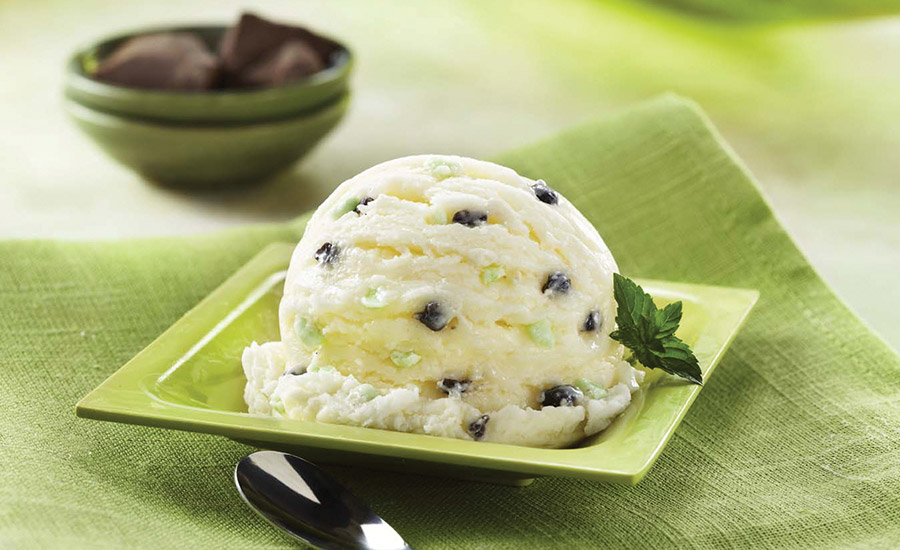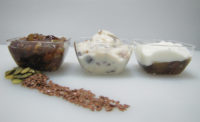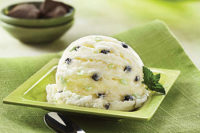Back in the good-old days, all it took to earn a consumer’s loyalty were a few well-placed ads, an occasional price markdown and a decent-enough taste to beat out the next-best competitor. These days, that won’t even land your product on the shelf.
The authors of “What Separates the Best Customers from the Merely Satisfied” in the Harvard Business Review write that the key to gaining — and keeping — contemporary consumers’ loyalty is to forge an emotional connection with them. And contemporary consumers, the authors write, “connect emotionally with brands when the brand resonates with their deepest emotional drives — things like a desire to feel secure, to stand out from the crowd or to be the person they want to be.”
That’s a heavy lift for any yogurt, ice cream or cheese spread. But it may be right in the wheelhouse of the premium iterations of such products, whose high-endje ne sais quoi all but croons, “Choose me, and you will be among the chosen.”
That, of course, raises the question of what it means to be premium in today’s dairy category. And while the definition remains a moving target, experts agree that nuts and inclusions help dairy items play the part. That being the case, we quizzed those experts on how best to use nuts and inclusions to convey premium cred, and why we should make the effort in the first place.
Dairy Foods: To start, has “premium” been on your radars — or more importantly, your customers’?
Khursheed Parakh, strategic marketing manager, Cargill Cocoa and Chocolate, Minneapolis: Today, we see premium being used on a number of different products. Research has shown that consumers are willing to pay extra for items with this word on the label.
Tom Payne, industry specialist, U.S. Highbush Blueberry Council, San Mateo, Calif.: We have noticed recent product introductions making a point in their marketing about being premium. There’s nothing subtle about the subtext — these products are announcing, “Hey, look at me! I’m not just another pretty face. I’m extra special and you deserve it.” There’s a reason Julia Child once said something like, “I’d rather have one tablespoon of premium ice cream than a whole tub of tofu.”
Dairy Foods: Amen to that. So what do you think explains premium’s popularity, both in the dairy case and elsewhere?
Rick Stunek, marketing and sales, Forbes Chocolate, Broadview Heights, Ohio: People are willing to pay for a premium product in order to take a break from a busy day, unwind and savor what they love. For many, eating bland, boring food would be just another daily task that they hurry to get through. But buying premium products, whether meals, snacks or drinks, helps return some civility to the day.
Parakh: Today’s consumers are attracted to premium because they’re looking for a sense of uniqueness and something better. This translates strongly into the food arena, where more consumers tend to eat outside the home and seek offerings in their food-shopping venues that provide discovery and newness.
Kevin W. Holland, product developer, Tree Top, Selah, Wash.: I think many consumers see premium products as a way to treat themselves.
Dairy Foods: That raises a good point — namely, that the Great Recession may officially be over, but money, for some, is still tight. Do economic downturns work against luxury positioning, or is that when premium really thrives?
Stunek: There’s no question that if the economy is down and dining out isn’t a frequent option, then purchasing premium products at the grocery store is a very strong substitute.
Holland: I think that for some categories it does work in this manner. Consumers may not have the money to splurge on premium clothes or gadgets, but they may have a few extra dollars to spend at the grocery store.
John Pimpo, sales manager – East, ingredients & contract manufacturing division, Gertrude Hawk Ingredients, Dunmore, Pa.: In all honesty, we have not seen any real decrease over the past few years in this category.
Dairy Foods: So I guess that makes premiumization a countercyclical phenomenon. But what else defines a food or drink as premium?
Parakh: Premium is not an FDA-determined adjective with a specific meaning, so consumers’ perceptions are impacted by different sources, including the packaging and company information, as well as word of mouth and social media.
Holland: New flavors, new textures, new benefits all play into the premium category. To take yogurt as an example, strawberry yogurt is probably not seen as a premium product. But if you use Greek-style yogurt or add balsamic vinegar to the flavor profile, then many will view it as premium.
Dairy Foods: In what other instances do we see premiumization in dairy?
Tanu Tokle, senior scientist, QualiTech, Chaska, Minn.: [Since the rise of Greek-style yogurt] “premium” was completely redefined as products were formulated with higher total dairy solids and that translated into creamier textures. As the trend has progressed, we see consumers being hungry for more flavor, color and intensity in the eating experience.
Pimpo: I think that for ice cream, at least, consumers tend to believe that premium should be dense with a higher-fat content than regular ice cream, while also using higher-quality ingredients.
Dairy Foods: “Higher-quality ingredients.” That sounds like clean labeling. What role does a simple ingredient statement play in consumers’ perception of premium?
Tokle: “Simplicity” in labeling involves using fewer ingredients, with easily identifiable names. Increasingly, premium is defined as meeting stringent ingredient label declarations, and the use of natural flavors and colors is a key part of that trend.
Stunek: Fresh products with clean, simple labels are a good start. But the product also has to taste good. A clean-labeled product made with inferior ingredients isn’t going to fool many of today’s premium consumers.
Dairy Foods: Can a premium dairy treat provide both decadence and good-for-you cachet, or does the former cancel out the latter in consumers’ minds?
Stunek: I don’t think there’s an easy answer to this. It depends upon the product. Premium just means “additionally great,” in most cases. If the product is viewed as healthy, then premium may mean “even healthier.” If the product is viewed as indulgent, then premium may mean “wildly decadent.”
Holland: Both decadent and good-for-you products can be viewed as premium. Consumers are willing to pay more for health benefits and an indulgent treat. They each have their places, and are purchased to fulfill a certain need.
Tokle: Consumers are looking for premium products because they usually translate into a more enjoyable experience. In the case of foods, this typically means “better for you” and/or more decadent flavors. That said, our experience has been that premium products are expected to deliver great nutritional profiles, natural ingredient declarations and fantastic taste quality.
Dairy Foods: Let’s discuss where inclusions fit into the picture. In which dairy applications are they making frequent guest appearances?
Tokle: Inclusions are successfully used in ice cream, novelties, yogurt and cheese in the form of mix-ins like granola, seeds or other healthy or indulgent ingredients. They can make the difference between a plain product and a top-selling SKU within a category.
Holland: Traditionally, fruit inclusions have been used extensively in both yogurt and ice cream. I think there’s tremendous opportunity in other dairy categories, such as cheese and milk.
Pimpo: We’ve seen a spark with traditional cultured dairy yogurt and dome-topper or sidecar inclusion development. Within the past two to four years we’ve seen a tremendous increase in gelato manufacturers using inclusions to create a new subcategory in ice cream: American gelato.
Dairy Foods: How do these inclusions turn standard dairy applications into premium products?
Pimpo: In terms of gelato, the traditional international form has thrived with only limited amounts of inclusions — nuts, fruits, chips et cetera — while focusing mainly on the base. American gelato manufacturers have seized the opportunity to take amazingly dense, rich gelato background flavors and combine them with indulgent inclusions, sparking a national craze.
Tokle: Inclusions like fruit, chocolate bits and even s’mores bits provide a point of color, flavor and texture and may also carry functional ingredients like fiber, protein, omega-3s, vegetable or fruit content and nutraceuticals.
Dairy Foods: Again, you’re describing a situation where “premium” connotes health-and-wellness benefits.
Tokle: Yes. Dairy products contain essential nutrients, including protein, minerals and vitamins, carbohydrates and essential fats. The ability to enhance any of these, or provide additional nutrients via the inclusion system, is a cost-effective, creative way to address the health-and-wellness market and, ultimately, build market share.
Payne: In fact, fruit is used to garnish indulgent treats as a way to grant permission to the reluctant. Blueberries are considered premium partly because they’ve become almost synonymous with good health. Even better, with blueberries, even the most indulgent frozen dessert can provide a full fruit serving. One quarter cup of dried fruit equals a fruit serving. Blueberries have always had a prominent place at the forefront of superfruit mystique — another prominent marker of premium identity.
Dairy Foods: Any other markers of premium inclusion identity you can share?
Parakh: Hazelnuts, pistachios and almonds tend to have a higher premium perception compared to peanuts and pecans.
Holland: For fruits, piece identity, color, high use rates, geographical source and health benefits can all signal a premium product. If consumers can see and feel the fruit pieces, then they know that there’s real fruit in the product. Color is another important attribute. I think being able to denote the geographical source can play some role if the named region is known for that particular inclusion.
Dairy Foods:What role does shape or visual novelty play in an inclusion’s premium identity?
Pimpo: Shell-molded inclusions come in classic shapes like cups, but they can elevate the scale of a flavor concept in a regal shape like a truffle. Additional shapes include turtles, hearts, stars or any multitude of options that can accentuate the branding element of a concept.
Dairy Foods: Chocolate poses an interesting case, because I would guess that the kind of “premium” chocolate formulation that consumers might prefer in a candy might not work so well in an actual ice cream inclusion. Am I right?
Pimpo: Real chocolate does tend to get hard and waxy in frozen ice cream, so most customers tend to use low-melt confectionery coatings.
Parakh: These compound inclusion products that do not fit the standard of identity for chocolate are formulated with oils that have lower melting points than the melting point of cocoa butter. When a frozen compound inclusion is eaten, it provides a better consumer experience because the inclusion melting point is lower than body temperature. This causes the inclusion to melt more readily in the consumer’s mouth, retaining a better mouthfeel, which adds to a premium experience.
Dairy Foods: What other tips can you share for deploying inclusions in dairy?
Pimpo: Most customers who want to keep the integrity of a porous inclusion like a nut or pretzel will coat that product with a low-melt confectionery coating. Most customers are looking for these inclusions to retain their crunch. This can generally be achieved with a varnish coat to keep moisture out and keep the premium crunch consumers are looking for.
Holland: [With fruit] low use rates will not convey the same premium impact as a higher use rate. Also, exotic or varietal fruits can aid in supporting a premium message. We’ve seen this recently with varietal apple juices. But while varietals are a great way to upscale a product, they do limit sourcing opportunities. To avoid this, use geographical designations like “made with California strawberries.”
Tokle: Real fruit will freeze and produce the texture of ice cubes. [Look for] inclusions [that] stay soft within the ice cream while adding great flavor, texture, function and visual appeal.
Payne: Dehydrated blueberries, diced or whole, are ideal in helping to bring out a sweet richness. IQF [individually quick frozen] blueberries can be used straight from the box. Freeze-dried products provide crisp flavor notes, tang and real fruit-flavor bursts. Available year round, blueberry juice and purée make excellent choices in formulations.



